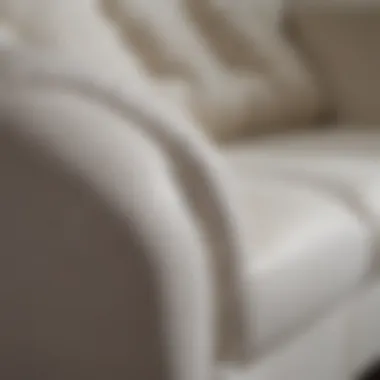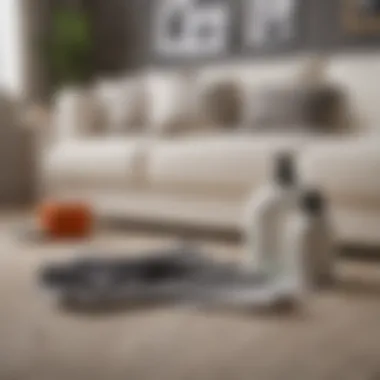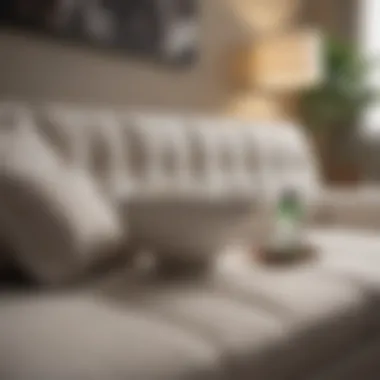Cleaning White Couch Fabric: A Comprehensive Guide


Intro
Cleaning white couch fabric requires knowledge and careful execution. White couches, while beautiful, can be challenging to maintain. They easily show stains, dirt, and signs of wear. This guide discusses various cleaning methods tailored to different types of fabrics in your couch.
We will explore tools and solutions that are effective yet gentle enough to prevent damage. Additionally, we will provide step-by-step techniques to clean your couch properly. Understanding the maintenance required can help you preserve the appearance of your furniture while extending its lifespan.
Design Inspirations
Trending Styles
In recent years, white couches have gained popularity in various interior design styles. They suit many aesthetics, from minimalistic to bohemian. The versatility of a white couch can complement diverse design inspirations. Pair it with vibrant colored throw pillows or a textured blanket to create a layered look.
Color Palettes
White couches fit seamlessly into color palettes filled with soft pastels or bold, contrasting hues. For a chic contrast, consider pairing the couch with dark wood furniture or metallic accents. These pairings create a striking visual appeal, elevating your living space. Consider using nature-inspired tones like greens and earth tones to add warmth to the decor without overwhelming the serene elegance of the white fabric.
Maintenance and Upkeep
Maintaining a white couch requires attention to detail. Regular care helps sustain its original charm.
Seasonal Maintenance Checklist
- Deep Clean: Schedule a thorough cleaning at least seasonal. This helps eliminate buildup.
- Check for Damages: Inspect seams and cushioning for any wear.
- Protect: Apply a fabric protector to shield against future stains.
Cleaning and Organization Tips
- Spot Clean Immediately: Address spills quickly to prevent stains from setting.
- Use Specific Cleaning Solutions: Different fabrics respond to various solutions. For cotton, a mixture of water and mild detergent is effective. Leather requires a special cleaner.
- Fluff Cushions Regularly: Keep your cushions looking fresh by fluffing them to maintain their shape.
Remember, regular maintenance enhances the overall look of your couch, prolonging its life and avoiding costly replacements.
By applying these cleaning methods and upkeep strategies, you can enjoy the elegance of your white couch, regardless of the challenges it may present. Following this guide will give your living room the bright, clean look it deserves.
Understanding White Couch Fabrics
Understanding the different types of fabrics used in white couches is key to maintaining their appearance. Each fabric has unique characteristics and care requirements. This section focuses on the types of fabrics, their properties, and why certain choices may be preferable for homeowners and design enthusiasts alike.
Types of Fabric Used in White Couches
Natural Fibers
Natural fibers are made from plant or animal sources. Common examples include cotton, linen, and wool. One key characteristic of natural fibers is their breathability, which provides comfort in various climates. They often offer a softer texture, which can enhance the overall look of a couch. Natural fibers are considered a beneficial choice for many due to their eco-friendliness and ability to absorb moisture. However, they tend to be more prone to staining and fading, which may pose challenges in cleaning.
Synthetic Fibers
Synthetic fibers such as polyester and nylon are manufactured from chemical compounds. The predominant advantage of synthetic fibers lies in their durability and resistance to stains. They are easier to clean compared to natural fibers, making them popular for households with children or pets. Another noteworthy feature of synthetic fibers is their wide range of colors and patterns, allowing for greater customization. However, they can sometimes lack the warmth and comfort associated with natural fabrics.
Blends and Their Properties
Blended fabrics combine both natural and synthetic fibers to create a hybrid material. This approach combines the benefits of both types of fabrics. For instance, a cotton-polyester blend may provide comfort and superior stain resistance simultaneously. This flexibility makes blends a popular choice for homeowners who desire aesthetic appeal and practicality. Nevertheless, the specific care requirements can vary depending on the blend ratio, thus requiring careful cleaning consideration.
Why White is a Popular Choice
Versatility in Design
The versatility of white couches contributes significantly to their popularity. They can seamlessly complement various decor styles, from modern to traditional. A white couch serves as a neutral base, allowing homeowners to experiment with vibrant cushions or throws. This flexibility is a key benefit for anyone looking to change their home’s aesthetic frequently.
Perceived Cleanliness
White couches are often associated with cleanliness and freshness. Their light color can enhance the perception of space and brightness within a room. This can be particularly beneficial in smaller areas, where darker colors may feel cramped. However, this perceived cleanliness is a double-edged sword; while they can look pristine, they are also more susceptible to showing dirt and stains.
Emphasis on Space
Another compelling reason for choosing white is the emphasis it places on spatial dimensions. White can create the illusion of a larger area, making it a fitting choice for those with limited living space. This characteristic can boost the room's overall aesthetic appeal, but careful consideration must be given to maintaining the fabric’s appearance to ensure that this effect is not undermined by visible stains.


Preparation for Cleaning
Preparation for cleaning white couch fabric is a crucial step that can determine the efficacy of your cleaning efforts. It sets the stage for a successful outcome, ensuring you approach the task methodically and effectively. The importance lies not only in understanding the type of fabric used but also in gathering the right tools and materials to achieve thorough cleaning.
Assessing the Fabric Type
Read Care Labels
Reading care labels is a first step in assessing the fabric type of your white couch. These labels provide essential information such as washing instructions, allowable cleaning products, and warnings against specific methods. Ignoring this information may lead to damage, such as color bleeding or fabric fraying. Care labels are a beneficial choice because they guide users in selecting the appropriate cleaning agents. One key feature of care labels is that they often differentiate between machine-washable and dry-clean only fabrics. This can help prevent costly mistakes in the cleaning process.
The advantage of reading care labels is clear - it allows informed decisions about cleaning methods. However, not all labels provide clear instructions, which can be a disadvantage for owners who lack knowledge about fabrics.
Conduct a Fabric Test
Conducting a fabric test is another important aspect of assessing your couch material. Before applying any cleaning solution broadly, a small test in an inconspicuous area can provide insight into how the fabric reacts. This test can prevent wide-scale fabric damage and ensure compatibility with cleaning agents. The key characteristic of conducting a fabric test is that it can reveal issues like discoloration or water spots before they affect the entire fabric.
A fabric test shines as a popular choice for those concerned about the integrity of their furniture. The unique feature of this process is its straightforward nature; it can be done with a simple solution and a cloth. While the advantage is that it minimizes risk, the disadvantage is that it may not always be feasible, especially with older fabrics that show signs of wear.
Gather Necessary Tools and Materials
Vacuum Cleaner
The vacuum cleaner is an indispensable tool when preparing to clean white couch fabric. It serves as the first line of defense, helping to remove dust, crumbs, and pet hair. Its contribution to a thorough cleaning cannot be understated, as effective vacuuming can prevent dirt from embedding deeper into the fabric. The key characteristic of a vacuum cleaner is its ability to reach into crevices and tight spots, areas that are often missed by manual cleaning methods.
Using a vacuum cleaner is a beneficial choice since it saves time and effort. A powerful model can pick up particles that might otherwise cause damage when rubbed against fabric. Nevertheless, one potential disadvantage is that not all vacuum cleaners are equipped with the right attachments suited for delicate fabrics, leading to potential damage if not used correctly.
Soft Brushes
Soft brushes are essential tools when preparing to clean white couch fabric. They are specifically designed to agitate dirt embedded in the fibers without causing harm. Their soft bristles can gently lift debris while avoiding scratches or damage to the surface of the fabric. One particular benefit of using soft brushes is the ability to target stubborn spots, where standard vacuuming may have failed.
Their gentle handling makes soft brushes a populor choice for maintenance and spot cleaning. However, they do require a careful approach; excessive pressure can lead to fabric damage, making it vital to use them with caution.
Cleaning Solutions
Cleaning solutions are critical to the overall success of the cleaning process. They can range from commercial products to homemade alternatives that are safe for use on fabric. Their contribution lies in their ability to break down stains and odors, restoring the couch's appearance. The key feature of effective cleaning solutions is their formulation, which can tackle various stains while preserving fabric integrity.
Selecting the right cleaning solution is an important choice for anyone involved in maintaining white couch fabric. Some products are specifically designed for upholstery and offer targeted stain-fighting properties. However, it is crucial to be aware of the disadvantages; not all solutions are safe for every fabric type, and some may contain harsh chemicals that can negatively affect your couch over time.
Always test cleaning solutions on a hidden area to avoid damaging the fabric.
Cleaning Techniques for White Couch Fabric
Cleaning white couch fabric requires a specific approach due to the nature of the material and the propensity for visible stains. This section discusses important techniques that homeowners can adopt to maintain their couch's aesthetics and integrity. Effective cleaning strategies not only help to preserve the fabric but also enhance the overall ambiance of the living space. Moreover, knowing how to clean different types of fabrics appropriately prevents damage and prolongs the couch's lifespan.
Vacuuming and Dusting
Importance of Regular Maintenance
Regular maintenance is essential for the longevity of white couch fabric. Dust and dirt can accumulate, leading to premature wear and discoloration. Frequent vacuuming helps to remove these particles before they settle into the fibers. This proactive approach minimizes the need for deep cleaning and can help retain the fabric's original look. Regular vacuuming can also reduce allergens, creating a healthier environment for occupants.
Best Practices for Vacuuming
To maximize the effectiveness of vacuuming, consider a few best practices. First, use a vacuum cleaner with a brush attachment to agitate the fabric gently. This method lifts dirt that might be trapped. Secondly, vacuum the couch at least once a week, focusing on crevices where dust may gather. It is also wise to check and clean the vacuum’s filter and brush regularly to ensure optimal suction power. Following these practices leads to a cleaner couch while maintaining its fabric integrity.
Spot Cleaning: A Step-by-Step Approach
Immediate Action on Stains
Immediate action on stains is crucial for a successful cleaning outcome. The longer a stain remains on the fabric, the harder it becomes to remove. When a spill occurs, swiftly blot the area with a clean cloth to absorb excess liquid. Avoid rubbing, as this might spread the stain or push it deeper into the fibers. Responding quickly minimizes the potential damage and keeps your couch looking pristine.
Applying Cleaning Solutions
Applying the correct cleaning solutions is a key step in effectively tackling stains. Use fabric-specific cleaners that are safe for your couch's material. Test the solution on a small, inconspicuous area before widespread application to ensure color fastness. When applying the cleaner, use a soft cloth and work from the outside of the stain toward the center to avoid creating a larger mark. This tailored approach allows for effective removal without risking further damage.


Patience in Drying
Patience in drying is often overlooked but is vital for preserving the fabric’s condition after cleaning. Avoid using high heat to speed up the drying process, as this can cause shrinkage or fading. Instead, allow the couch to air dry completely, ideally in a well-ventilated area. If possible, place fans nearby to enhance airflow. This method prevents moisture build-up, which can lead to mold or mildew formation, ensuring long-lasting cleanliness.
Dealing with Common Stains
Dealing with common stains on white couch fabric is crucial for maintaining the aesthetic appeal and longevity of the furniture. White couches are particularly prone to visible stains, which can detract from their cleanliness. Addressing these stains promptly can prevent them from setting in and becoming more difficult to remove. With the right knowledge and techniques, homeowners can effectively tackle issues such as food spills, ink marks, and pet accidents. This section will delve into common sources of stains and how to treat them effectively.
Food and Beverage Stains
Food and beverage stains are among the most frequent culprits for white couch fabric. They occur often due to social gatherings or casual meals on the couch. Knowing how to treat these stains efficiently can keep the fabric looking its best.
Coffee Stains
Coffee stains can be serious threats to the pristine look of a white couch. They can spread quickly and may become ingrained in the fibers if not managed immediately. The dark pigment in coffee makes it especially challenging to clean without the proper approach. This stain type is popular for discussion because coffee is a common beverage in many households. It demonstrates how a casual moment can quickly turn into a worrying situation.
To address coffee stains, it's vital to act quickly. Blot the area with a clean cloth to absorb excess liquid. Often, a mixture of water and mild detergent can be applied to lift the stain away. Failure to treat it promptly can lead to permanent discoloration.
Red Wine Marks
Red wine marks are another prevalent issue for fabric-covered couches. The pigments found in red wine are known for their staining properties. This is why red wine marks are highlighted in discussions about fabric care. Addressing these stains quickly is essential since they can easily establish themselves in the fabric.
A common method for treating red wine stains involves covering the area with salt to absorb the liquid. Once the salt absorbs, a cleaning solution of water and detergent is often recommended. Red wine stains illustrate a unique challenge that, if faced with care, can lead to effective removal and preservation of the fabric.
Ink and Pet-Related Stains
Ink and pet-related stains are distinct in their persistence. Ink can come from various sources, such as pens or markers, while pet accidents can be both liquid and solid. Each of these stain types requires a specialized approach for effective removal.
Ink Removal Techniques
Ink stains pose a significant challenge due to their tendency to spread quickly. They are frequent subjects in discussions about fabric care. Ink stains are notorious for their deep pigmentation, often making them seem impossible to treat. However, knowing the right ink removal techniques can dramatically change the outcome.
Applying rubbing alcohol to a cotton ball and gently dabbing the stain can often lift the ink. Avoid rubbing or scrubbing, as this can worsen the stain. Understanding the specific nature of ink and its chemical makeup can enhance any treatment plan.
Handling Pet Accidents
Handling pet accidents is essential for any pet owner to consider in fabric care. Pets are unpredictable, and issues can arise unexpectedly. Pet accidents present a unique challenge due to their biological components, which can lead to lingering odors and stains.
Immediate action is crucial. Begin by blotting the area with paper towels, ensuring to absorb as much as possible before applying a cleaning solution. Products specifically designed for pet stains can be beneficial since they often contain enzymes that break down organic compounds effectively. Recognizing the importance of reflection after an accident can lead to better long-term care for both the couch and the pet.
Alternative Cleaning Methods
Alternative cleaning methods provide valuable options for maintaining white couch fabrics. These methods encompass a variety of techniques that can enhance cleaning efficiency and minimize the risk of damage. Understanding these approaches can lead to better preservation of your couch, ensuring longevity and aesthetic appeal.
Through the use of steam cleaning and professional services, homeowners can address stubborn stains and generalized dirt without compromising the integrity of their fabric. This section will explore two main methods: using steam cleaners and engaging professional cleaning services.
Using Steam Cleaners
Understanding Steam Cleaning
Steam cleaning is a popular method that uses high-temperature steam to clean various surfaces, including white couch fabrics. This technique is effective in loosening dirt and stains, making it easier to remove them without the use of harsh chemicals. One key characteristic of steam cleaning is its ability to sanitize, as the heat effectively kills bacteria and dust mites that may reside in the fabric. This makes it a beneficial choice for homeowners looking for an eco-friendly cleaning alternative.
A unique feature of steam cleaning is its deep cleaning capability. With the right equipment, it can reach into the fibers of the fabric, extracting embedded dirt and allergens. The main advantage is that it usually requires minimal cleaning solutions, which can be appealing for those concerned about chemical residues. However, a disadvantage is that using steam on certain fabrics may lead to water damage or shrinkage, so testing is essential before use.
Safety Considerations
Safety considerations are critical when utilizing steam cleaners. One of the primary concerns is ensuring that the steam cleaner is operated at the recommended temperature settings. High temperatures can damage delicate fabrics; therefore, proper adjustment is necessary throughout the cleaning process. Another key aspect is ensuring adequate ventilation. Working in tight spaces without air circulation can lead to discomfort and overheating.
Additionally, knowing the right distance to hold the steam nozzle is important. Keeping it too close can scorch the fabric, while positioning it too far reduces cleaning efficiency. A unique feature of safety considerations is the training or familiarity with the equipment. Proper instruction on how to operate the steam cleaner can prevent accidents and achieve better results. Although steam cleaning presents many advantages, one must remain cautious to avoid potential mishaps.
Professional Cleaning Services
When to Consider a Professional


Engaging professional cleaning services can be a wise decision for maintaining the pristine condition of white couch fabric. One specific aspect of opting for these services is the specialized equipment and expertise that professionals bring. They often have access to advanced cleaning technologies that are not available for home use. This becomes particularly valuable for tough stains that resist DIY efforts or set-in marks that require an expert touch.
A key characteristic of considering professional help lies in the depth of cleaning provided. Professionals can offer tailored solutions based on the specific fabric type and stain nature, ensuring appropriate treatment. The unique feature of this option is its convenience—outsourcing cleaning tasks can save time and effort for busy homeowners. However, a disadvantage may be the cost associated with these services, which can vary widely depending on location and level of service.
Questions to Ask a Service
When considering professional cleaning services, it's essential to ask relevant questions. This ensures that you receive the best possible care for your couch. One of the critical questions is about the cleaning methods they employ. Understanding whether they use steam cleaning, dry cleaning, or other methods helps you assess fit for your fabric type.
Another vital aspect is to inquire about their experience with the specific material of your couch. Professionals with extensive experience dealing with similar fabrics can provide greater assurance. The unique feature of this process is that asking questions can build trust and clarity. This interaction can also reveal any additional services offered, like fabric protection treatments or warranties.
In summary, alternative cleaning methods, including steam cleaning and the utilization of professional services, provide distinct advantages for white couch fabric maintenance. By being informed and deliberate in decision-making, homeowners can ensure their furniture remains in excellent condition.
Long-Term Maintenance Strategies
Long-term maintenance strategies are crucial for preserving the beauty and functionality of white couch fabric. Such strategies can not only extend the lifespan of the couch but also maintain its aesthetic appeal. Routine care is essential, as it helps in minimizing wear and tear, preventing stains from setting in, and ensuring the fibers remain in good condition. This proactive approach can save time and money in the long run.
Protective Coverings and Treatments
Fabric Protectors
Fabric protectors offer a significant advantage in maintaining white couches. These are specialized sprays designed to create a barrier against stains and spills. The key characteristic of fabric protectors is their ability to repel liquids, making it easier to clean up any accidents that might occur. This makes them a beneficial choice for homeowners who value both cleanliness and the integrity of their furniture.
One unique feature of fabric protectors is their versatility. They can be applied to various fabric types, whether natural or synthetic. However, a potential disadvantage to consider is that some protectors may alter the fabric's texture or appearance. Thus, it is advisable to test a small area before full application.
Slipcovers
Slipcovers serve as another effective method for protecting white couch fabric. They can be easily removed and cleaned, making them a practical option for those who entertain frequently or have children and pets. The main characteristic of slipcovers is their ease of maintenance; they can be laundered, which helps in maintaining a fresh appearance. This flexibility makes them a popular choice among many homeowners.
A unique feature of slipcovers is the variety of styles and materials available. They can range from casual cotton to sophisticated linen. However, a downside might be the potential for slipcovers to shift or bunch during use, requiring occasional adjustments.
Regular Cleaning Schedule
Daily Care Tips
Establishing daily care tips is essential for maintaining the pristine appearance of white couch fabric. This involves simple actions that can significantly impact the couch's cleanliness. For instance, regular fluffing of cushions helps maintain their shape and prevents wear. The key characteristic is that these quick maintenance steps do not require much time or effort.
Engaging in daily care tips is beneficial, as they can help reduce the frequency of deep cleaning. However, one unique aspect to consider is that daily care should not replace thorough cleaning sessions. It serves more as a supplement to regular upkeep.
Monthly Deep Cleaning
Monthly deep cleaning sessions are vital to keep white couches looking new. This process typically involves more intensive methods, such as professional cleaning products or steam cleaning. The main characteristic is that these sessions can remove dirt and grime that accumulate over time.
Monthly cleaning is beneficial as it ensures that no stains or dirt become embedded in the fabric, preserving the couch’s appearance. One unique feature of this process is that it can be tailored to the specific fabric type. However, inconvenience can sometimes arise due to the time required for deep cleaning, which may not always fit into a busy schedule.
Effective long-term maintenance not only simplifies upkeep but also enhances the overall longevity of furniture.
Final Considerations
In any undertaking, particularly when it comes to the maintenance of a white couch, it is crucial to examine the final considerations that accompany the journey of cleaning and upkeep. This segment acts as a pivotal closure to the ideas acquired throughout the article. Any decision made regarding cleaning techniques or future fabric choices must account for the balance of practicality against aesthetic appeal while keeping costs manageable.
Understanding the Trade-offs
Style vs. Practicality
When selecting a fabric for a white couch, one must confront the dichotomy of style versus practicality. The allure of a stylish white couch is undeniable; its minimalist appearance enhances many interior designs. However, the inherent vulnerability of white fabrics to stains and wear can be a source of anxiety for homeowners. A key characteristic here is the emotional connection to visual appeal. Maintaining the intended aesthetic comes at a price; it is often necessary to invest time and energy in regular cleaning and careful handling. This is particularly beneficial in spaces where gatherings occur frequently, as guests may inadvertently compromise the couch's pristine look. Understanding this balance helps one appreciate the choices involved, whether it is a matter of selecting a high-maintenance, visually striking fabric or opting for a more subdued yet practical alternative.
Cost Implications
Cost implications related to maintaining a white couch can vary significantly. The initial purchase price of a fabric can often be misleading. While it may seem economical at first, it is essential to consider the long-term financial responsibility associated with upkeep. Choosing certain types of fabric might require spending on specialized cleaning products or services. A major consideration in this context is the potential frequency of replacements due to wear or extent of stains. A more durable fabric may have a higher cost upfront but could save money in repairs or replacements over time. Being aware of these factors aids in making informed decisions that align with one's budget while ensuring the long-term beauty of the couch remains intact.
Choosing the Right Fabric for Future Purchases
Evaluating Durability
Durability should be a primary concern when strategizing future couch purchases. Sourcing materials that withstand wear and tear will save on future costs and provide peace of mind. Fabrics such as leather or tightly woven textiles offer superior resistance to the everyday accidents life throws your way. An important characteristic of durability is the associated lifespan of the fabric; it determines how often you might need to seek replacements. This leads to both a financial and practical benefit when choosing the right fabric. Investing in durable materials can translate to less frequent cleaning and maintenance, which is particularly advantageous for households with children or pets.
Considering Maintenance Requirements
Maintenance requirements are another fundamental aspect to consider when buying fabric for a white couch. Prospective buyers should assess the ease with which a fabric can be cleaned or treated. Some materials may simply need a quick wipe down, while others might demand more extensive cleaning techniques like those discussed earlier. A critical element is to ensure that the fabric fits within your lifestyle. Choosing a low-maintenance option can be appealing for busy individuals. The trade-off could arise if those low-maintenance fabrics come at the cost of style or comfort. Ultimately, weighing these maintenance considerations helps to ensure you make a choice that will not only serve aesthetic purposes, but also your overall living environment.







